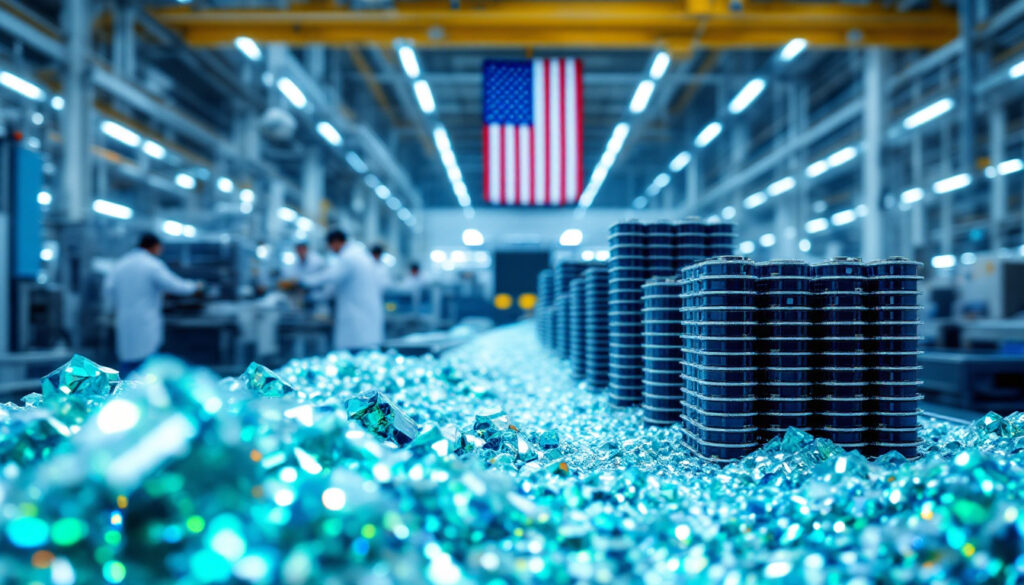The Rise of Western CAM: Reshoring U.S. Battery Materials Production
As the United States races to secure its energy future, Western CAM emerges as a pivotal player in reshoring critical battery materials production. Launched in April 2025, this innovative company is poised to transform America's battery supply chain by manufacturing cathode active materials (CAM) domestically. With the global battery market expanding rapidly, Western CAM's focus on proven technologies and cost-competitive manufacturing represents a strategic shift in U.S. industrial policy.
What is Western CAM and Why Does It Matter?
Western CAM is a U.S.-based manufacturer specializing in lithium iron phosphate (LFP) and lithium manganese iron phosphate (LMFP) cathode active materials – essential components that determine battery performance, cost, and safety. The company's significance stems from its mission to reshore production of these materials, which have become critically important as LFP batteries now comprise approximately 40% of global EV cathode demand.
The Strategic Mission of Western CAM
Western CAM's core mission extends beyond mere manufacturing – it aims to revitalize American leadership in battery materials production. As Isobel Sheldon, Global CEO, emphasizes: "We're reshaping the future of American energy independence by re-shoring materials originally developed in the U.S." This approach focuses on executable solutions rather than speculative technologies, prioritizing "proven materials, mature processes, and scaling" to meet immediate market demands.
The company has already secured its first Letter of Intent (LOI) with a U.S.-based customer, signaling strong commercial interest in domestically produced CAM that complies with federal manufacturing requirements.
Critical Role in U.S. Battery Supply Chain Independence
Western CAM addresses a fundamental vulnerability in America's energy transition: over 90% of global LFP production currently occurs in China. This dependency creates significant supply chain risks and economic disadvantages for U.S. manufacturers. By producing CAM domestically, Western CAM helps manufacturers avoid the 25% tariffs imposed on imported materials while ensuring compliance with the Inflation Reduction Act (IRA) requirements for federal incentives.
"This isn't about waiting for breakthroughs—it's about executing proven chemistries affordably," notes Sheldon. The company's approach reflects a pragmatic response to urgent policy priorities around energy security and industrial competitiveness.
The Significance of Domestic Cathode Active Materials Production
The cathode typically represents 30-40% of a battery's total cost, making it the single most expensive component. Western CAM's domestic production capability promises to reduce U.S. battery costs by potentially 15% by 2030 through elimination of tariffs and transport costs. Moreover, their proprietary processes reportedly achieve 95% material utilization compared to the industry average of 88%, further enhancing cost competitiveness.
For U.S. battery manufacturers and automakers, this means access to IRA-compliant materials that qualify for crucial tax credits while reducing dependency on volatile international supply chains.
How Western CAM is Transforming U.S. Battery Materials Production
Western CAM's approach to transformation centers on three key elements: proven technologies, scaled manufacturing, and strategic timing.
Initial LFP Sample Production Phase
The company is currently in its initial sample production phase, with completion targeted for Q2 2025. This milestone will enable potential customers to validate material quality and performance for their specific applications. Rather than promising distant breakthroughs, Western CAM focuses on delivering qualified materials that meet immediate industry needs.
Their facility design incorporates modular scaling capabilities, allowing for rapid expansion as demand increases. This pragmatic approach reflects the leadership team's extensive experience in global battery production.
Cost Competitiveness with Imported Materials
Perhaps most remarkably, Western CAM claims it will achieve cost parity with offshore suppliers without relying on subsidies. The company targets production costs of approximately $50/kWh for CAM versus $55/kWh for Asian imports after accounting for tariffs. This cost advantage stems from their optimized manufacturing processes that reduce energy consumption, water usage, and waste generation.
Sheldon asserts that "quality and cost competitiveness are achievable without subsidies," challenging the notion that domestic manufacturing necessarily commands a premium.
Compliance with U.S. Manufacturing Requirements
Western CAM's strategic value extends to regulatory compliance. The IRA mandates 50%+ CAM domestication by 2027 for electric vehicles to qualify for tax credits. By establishing domestic production ahead of this deadline, Western CAM provides manufacturers with a pathway to maintain their competitive positions while meeting increasingly stringent domestic content requirements.
The company's facility location prioritizes proximity to emerging U.S. lithium refineries, further strengthening the domestic supply chain ecosystem.
Key Milestones in Western CAM's Development
Western CAM's development timeline reflects its focused strategy of delivering proven solutions to pressing market needs.
Q2 2025 Completion Timeline for Initial Production
The company's immediate focus is completing its initial sample production capabilities by Q2 2025. This milestone will enable potential customers to validate material quality and performance within their specific applications. The rapid development timeline demonstrates the team's confidence in their mature production processes.
First Letter of Intent (LOI) for Offtake Secured
In a significant validation of market demand, Western CAM has already secured its first Letter of Intent from a U.S.-based customer, reportedly one of the top five U.S. automakers. Sheldon notes that "early customer engagement reflects demand for compliant supply," suggesting strong commercial interest ahead of actual production.
This early commitment highlights the urgent need for domestically produced CAM that meets both performance and regulatory requirements.
Commercial Deployment Planning for Large-Scale Facility
Beyond initial production, Western CAM is simultaneously planning its large-scale commercial facility. The modular approach allows for phased expansion aligned with customer commitments, optimizing capital efficiency while ensuring reliable supply to early adopters.
This parallel development strategy differentiates Western CAM from competitors who may pursue more sequential, and potentially slower, scaling approaches.
What Technologies is Western CAM Focusing On?
Western CAM's technology focus is deliberately targeted toward mature, high-demand chemistries with proven market applications.
Lithium Iron Phosphate (LFP) Production
LFP chemistry forms the cornerstone of Western CAM's initial production plans. This technology has gained tremendous market momentum, with LFP and related chemistries now accounting for approximately 60% of new U.S. battery projects. LFP offers compelling advantages in safety, cycle life, and cost, making it particularly well-suited for electric vehicles and grid storage applications.
The company's leadership team includes developers of what they describe as the "most efficient LFP production method," providing a foundation of intellectual property and practical know-how.
LMFP Cathode Materials Development
In parallel with LFP production, Western CAM is developing lithium manganese iron phosphate (LMFP) capabilities. As Sheldon explains, "LMFP enhances energy density without compromising LFP's safety," offering higher voltage (3.8V vs. LFP's 3.2V) while maintaining thermal stability advantages.
This dual-chemistry strategy positions Western CAM to serve both current and emerging market segments, from affordable EVs to longer-range premium vehicles.
Proven Manufacturing Processes vs. Experimental Technologies
Perhaps most distinctively, Western CAM explicitly avoids what Sheldon calls the "science experiment trap of unproven tech." Instead of pursuing speculative breakthroughs, the company focuses on optimizing mature processes that can be scaled reliably and economically.
This approach addresses a common pitfall in battery manufacturing, where promising laboratory results often fail to translate into affordable, high-quality mass production.
Who's Behind Western CAM?
The company's leadership represents a considerable concentration of battery industry expertise with direct experience in global CAM production.
Leadership Team Experience
Western CAM's team brings over 25 years of battery commercialization experience, including senior roles at major manufacturers and research institutions. Their collective credentials reportedly include more than 50 patents in cathode synthesis and production methods, providing a strong foundation of intellectual property.
This depth of practical experience is particularly valuable in an industry where theoretical knowledge must be complemented by manufacturing know-how to achieve commercial success.
Isobel Sheldon's Vision as Global CEO and Co-Founder
Isobel Sheldon, the company's Global CEO, brings extensive experience from leadership roles including the UK Battery Industrialisation Centre. Her vision emphasizes practical execution over speculative technology: "Our team has 'been there, done that' in scaling global production."
Sheldon's approach reflects a deep understanding of the challenges in transitioning from laboratory innovation to high-volume manufacturing, particularly in the complex world of battery materials.
Original Developers of Efficient LFP Production Methods
Notably, Western CAM's technical leadership includes key figures who developed highly efficient LFP production methods now deployed globally. The company's CTO reportedly led innovations that reduced LFP production costs by 30% at a major Asian manufacturing plant, expertise now being applied to Western CAM's domestic facilities.
This direct experience with successful process optimization provides credibility to the company's cost competitiveness claims.
How Does Western CAM Address U.S. Energy Security?
Western CAM's business model directly addresses critical vulnerabilities in America's energy transition strategy.
Reducing Dependency on Foreign Battery Materials
With 90% of global LFP production based in China as of 2024, U.S. battery and EV manufacturers face significant supply chain risks. Western CAM's domestic production capability provides a strategic alternative, reducing vulnerability to trade disputes, China's lithium export controls, or supply disruptions.
As demand for LFP batteries continues to grow for both EV and grid applications, this dependency would otherwise increase without domestic alternatives.
Tariff Advantages of Domestic Production
Beyond supply security, Western CAM offers immediate economic advantages through tariff avoidance. Sheldon highlights that "tariff-free CAM strengthens U.S. OEM cost positions" by eliminating the 25% tariffs imposed on imported materials under Section 301.
This cost advantage translates directly to improved competitiveness for U.S. manufacturers in both domestic and export markets.
Supporting U.S. Industrial Strategy for Energy Transition
Western CAM's approach aligns closely with broader U.S. industrial policy goals around clean energy manufacturing. By establishing domestic CAM production ahead of IRA compliance deadlines, the company helps bridge a critical gap in America's battery ecosystem.
The strategic location of their facilities near emerging lithium refineries further strengthens the integrated domestic supply chain that policymakers have prioritized.
What Makes Western CAM's Approach Different?
In a sector often characterized by hype around breakthrough technologies, Western CAM's differentiation lies in its focus on practical execution.
Focus on Proven Chemistries Rather Than Experimental Technologies
Western CAM deliberately targets mature chemistries with established market demand rather than pursuing more speculative alternatives. By focusing on LFP and LMFP, they address immediate market requirements while avoiding the technical and commercial risks of unproven technologies.
This approach contrasts with competitors pursuing silicon anodes, solid-state electrolytes, or other emerging technologies that face uncertain commercialization timelines.
Cost-Competitive Manufacturing Processes
The company's manufacturing processes reportedly achieve material utilization rates of 95% compared to industry averages around 88%. This efficiency translates to reduced waste, lower energy consumption, and ultimately more competitive pricing without relying on subsidies.
Their target of $50/kWh CAM production costs represents a significant milestone in domestic manufacturing competitiveness.
Scaling Established Technologies vs. Waiting for Breakthroughs
Unlike approaches that prioritize fundamental innovation, Western CAM focuses on scaling established technologies to meet immediate market demands. As Sheldon emphasizes, "We're avoiding the 'science experiment' trap of unproven tech" by leveraging the team's practical experience in global production environments.
This execution-focused strategy addresses the urgent need for domestic capacity rather than promising distant technological leaps.
Market Impact and Industry Applications
Western CAM's production capabilities have broad implications across multiple sectors of the clean energy economy.
Electric Vehicle Battery Supply Chain
The automotive sector represents Western CAM's primary market focus, with U.S. LFP demand projected to reach 200 GWh annually by 2030. Their secured LOI with a major U.S. automaker demonstrates immediate market validation for domestic CAM that meets both performance and regulatory requirements.
As automakers increasingly adopt LFP chemistry for entry and mid-range EVs, Western CAM's production addresses a critical supply chain bottleneck.
Grid Storage Solutions
Beyond transportation, LFP batteries have become increasingly dominant in grid storage applications due to their safety, longevity, and cost advantages. Sheldon notes that "grid storage is our secondary focus after automotive," reflecting the growing demand for stationary energy storage to support renewable integration.
LFP's thermal stability makes it particularly well-suited for outdoor energy storage systems in extreme climates, addressing reliability concerns for utility-scale applications.
Energy Infrastructure Applications
Western CAM's materials also have potential applications in emerging energy infrastructure sectors, from backup power systems to microgrids. The domestic production capability helps infrastructure providers meet Buy American provisions for federal projects while ensuring reliable supply for critical systems.
As electrification accelerates across the economy, these diverse applications provide Western CAM with multiple growth vectors beyond traditional automotive markets.
How Does Western CAM Compare to Global Competitors?
Western CAM enters a competitive global landscape dominated by established Asian manufacturers with significant scale advantages.
Cost Structure Analysis vs. Offshore Suppliers
The company's claimed production costs of $50/kWh for CAM materials compare favorably to the effective $55/kWh cost of Asian imports after accounting for tariffs. This cost competitiveness, if achieved, would represent a significant milestone for U.S. manufacturing capabilities.
Their optimized processes reportedly reduce both capital and operating expenses compared to traditional manufacturing methods, narrowing the historical cost gap with Asian suppliers.
Tariff Advantages for U.S. Manufacturers
U.S. battery and EV manufacturers face increasing pressure to source components domestically to maintain tax credit eligibility. Western CAM's materials would qualify under IRA provisions requiring 50%+ domestic CAM content by 2027, providing a strategic advantage over imported alternatives regardless of base price.
This regulatory alignment creates a structural tailwind for Western CAM's business model.
Quality and Performance Benchmarks
Beyond cost considerations, Western CAM emphasizes material quality and consistency as competitive differentiators. Their production processes reportedly achieve tighter particle size distribution and more consistent elemental composition than typical imported materials, potentially improving battery performance and manufacturing yields.
These quality advantages may prove particularly valuable for high-performance applications where consistency directly impacts battery life and safety.
What's Next for Western CAM and U.S. Battery Materials Production?
Western CAM's development roadmap reflects both immediate production goals and longer-term expansion plans.
Future Production Capacity Targets
Following the initial sample production phase, Western CAM intends to scale rapidly toward commercial volumes. While specific capacity targets remain undisclosed, their modular approach allows expansion aligned with customer commitments and market growth.
The company's infrastructure and process design reportedly accommodate multiple expansion phases without fundamental redesign, enabling responsive scaling as demand increases.
Potential Impact on U.S. Battery Supply Chain
As Western CAM moves toward full-scale production, its impact on the broader U.S. battery ecosystem could extend beyond direct materials supply. By establishing domestic CAM manufacturing, the company helps create demand for upstream lithium processing and refining while supporting downstream cell and pack production.
This integrated supply chain development addresses a critical gap in America's battery manufacturing capability.
Long-Term Vision for Domestic Battery Materials Manufacturing
Western CAM's leadership expresses a long-term vision of comprehensive domestic battery materials production. Beyond initial LFP and LMFP focus, the company's intellectual property and process knowledge could potentially extend to additional chemistries as market demands evolve.
Their strategic approach prioritizes establishing commercial success with proven materials before expanding into more speculative technologies, building credibility through execution rather than promises. With ongoing global lithium oversupply insights and lithium market trends indicating price volatility, Western CAM's focused strategy may provide stability in an otherwise turbulent landscape.
FAQ About Western CAM and U.S. Battery Materials Production
What is the significance of reshoring CAM production?
Reshoring CAM production reduces dependency on foreign suppliers (primarily Chinese), eliminates 25% import tariffs, ensures compliance with IRA requirements for tax credits, and strengthens America's energy security by localizing critical battery materials manufacturing. As cathodes represent 30-40% of battery costs, domestic production significantly impacts overall U.S. battery economics.
How does Western CAM's process differ from competitors?
Western CAM emphasizes proven manufacturing processes over experimental technologies, achieving reported material utilization rates of 95% versus industry averages of 88%. Their approach prioritizes scaling established chemistries rather than pursuing speculative breakthroughs, with production methods that reportedly reduce energy consumption and waste generation compared to traditional techniques.
What battery chemistries will Western CAM produce?
Western CAM initially focuses on lithium iron phosphate (LFP) production while developing lithium manganese iron phosphate (LMFP) capabilities. LFP offers advantages in safety, longevity and cost, while LMFP provides higher energy density (3.8V vs. 3.2V) while maintaining thermal stability benefits. These chemistries address both current market demands and evolving performance requirements.
How will this impact the U.S. battery supply chain?
Western CAM's production addresses a critical gap in America's battery ecosystem, potentially
Ready to Capitalise on ASX Mining Discoveries?
Stay ahead of the market with instant notifications on significant ASX mineral discoveries through Discovery Alert's proprietary Discovery IQ model, turning complex mineral data into actionable insights for both short-term traders and long-term investors. Explore historic examples of exceptional returns by visiting Discovery Alert's dedicated discoveries page and begin your 30-day free trial today.




